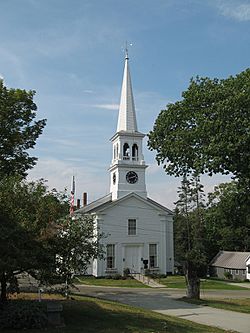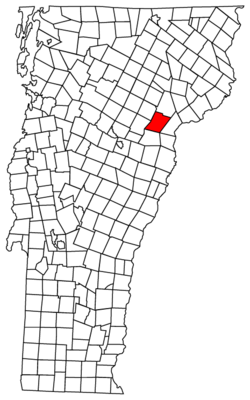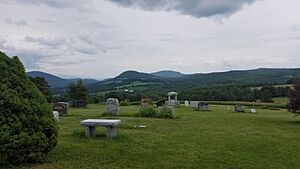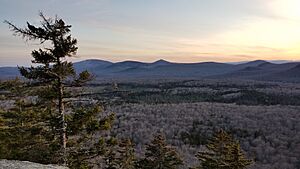Peacham, Vermont facts for kids
Quick facts for kids
Peacham, Vermont
|
|
|---|---|

Peacham Congregational Church
|
|

Location of Peacham in Vermont
|
|
| Country | United States |
| State | Vermont |
| County | Caledonia |
| Communities | Peacham East Peacham Ewells Mills Green Bay South Peacham |
| Area | |
| • Total | 47.7 sq mi (123.5 km2) |
| • Land | 46.6 sq mi (120.8 km2) |
| • Water | 1.0 sq mi (2.7 km2) |
| Elevation | 1,526 ft (465 m) |
| Population
(2020)
|
|
| • Total | 715 |
| • Density | 15/sq mi (5.9/km2) |
| Time zone | UTC-5 (Eastern (EST)) |
| • Summer (DST) | UTC-4 (EDT) |
| ZIP codes | |
| Area code(s) | 802 |
| FIPS code | 50-54400 |
| GNIS feature ID | 1462171 |
Peacham is a small town in Caledonia County, Vermont, in the United States. In 2020, about 715 people lived there. It is known for its beautiful scenery and quiet charm.
Contents
History of Peacham
Early Beginnings (1763-1784)
In 1763, Governor Benning Wentworth of New Hampshire gave a special paper, called a charter, for the Peacham area. The town was named Peacham, but no one is sure why. The first owners of the land were people who bought and sold land for profit. They mapped out the town and built some basic roads. However, no one lived there for a while.
First Settlers and Community Life
In 1775, families from Connecticut and Massachusetts started to move to Peacham. They bought land and built homes. These early settlers were mostly farmers. They grew their own food to survive, even with long winters and rocky soil. By 1784, about 200 people lived in Peacham. The town held its first official meeting that year. People elected leaders to help run the town.
Peacham had to choose between having a county courthouse or a county school. The people chose the school. In 1795, the Caledonia County Grammar School opened. The first school building was a simple log cabin. It was located between Peacham Corner and South Peacham.
Growth and Changes (1799-1840)
A library was started in 1799. It moved from store to store in town. A congregational church was also founded in 1794. Its first pastor, Leonard Worcester, was famous for his powerful speeches. His son, Samuel, became an important missionary. He worked with the Cherokee people. Samuel helped create the first type for the Cherokee alphabet.
Early residents of Peacham, called Peachamites, traded farm goods like butter and eggs. They also sold things like whiskey and potash (a chemical used in soap). This helped them earn money because farming was hard. Many different businesses grew in Peacham. These included lumber, barrel making, and leather goods.
From 1800 to 1830, sheep farming became very popular. It was more profitable than growing crops. In 1840, Peacham had its largest population ever, with 1,443 people. After this, the population slowly started to shrink. Farmers changed from raising sheep to dairy farming. Larger farms meant that fewer people were needed for work. Young people began to leave Peacham to find jobs elsewhere.
Modern Times (20th Century)
In the 20th century, Peacham's population continued to drop. Farming also became less common. This was because bigger dairy farms in other parts of the country offered more competition. Many farms in Peacham either joined together or closed down.
Tourism became important during this time. People from cities like Boston and New York City started visiting Peacham. They often stayed in homes that were opened to visitors. With the arrival of railroads and cars, Peacham became a popular summer spot. Some visitors were teachers and thinkers. Their presence added to the town's cultural life.
Geography of Peacham
Peacham covers about 123.5 square kilometers (47.7 square miles). Most of this area is land, with a small amount of water.
Neighboring Towns
Peacham is surrounded by several other towns. To the north is Danville. To the east is Barnet. To the southeast is Ryegate. To the south is Groton. To the west is Marshfield. And to the northwest is Cabot. No main state highways pass through Peacham.
Highest Point
The highest point in Peacham is Cow Hill. Its summit is about 782 meters (2,566 feet) high. It is located near the northern part of the town.
Population Information
| Historical population | |||
|---|---|---|---|
| Census | Pop. | %± | |
| 1790 | 365 | — | |
| 1800 | 873 | 139.2% | |
| 1810 | 1,301 | 49.0% | |
| 1820 | 1,294 | −0.5% | |
| 1830 | 1,351 | 4.4% | |
| 1840 | 1,443 | 6.8% | |
| 1850 | 1,377 | −4.6% | |
| 1860 | 1,247 | −9.4% | |
| 1870 | 1,141 | −8.5% | |
| 1880 | 1,041 | −8.8% | |
| 1890 | 892 | −14.3% | |
| 1900 | 794 | −11.0% | |
| 1910 | 777 | −2.1% | |
| 1920 | 657 | −15.4% | |
| 1930 | 620 | −5.6% | |
| 1940 | 543 | −12.4% | |
| 1950 | 501 | −7.7% | |
| 1960 | 433 | −13.6% | |
| 1970 | 446 | 3.0% | |
| 1980 | 531 | 19.1% | |
| 1990 | 627 | 18.1% | |
| 2000 | 665 | 6.1% | |
| 2010 | 732 | 10.1% | |
| 2020 | 715 | −2.3% | |
| U.S. Decennial Census | |||
Demographics of Peacham
Demographics is the study of a population. It looks at things like how many people live somewhere, their ages, and their backgrounds.
As of 2010, Peacham had 732 people living in 299 households. Most of the people (98%) were White. A small number of people were African American, Native American, or of two or more races.
About 25.8% of households had children under 18. The average household had 2.45 people. The average family had 2.90 people.
The population in Peacham is generally older. The average age was 48.5 years old. About 17.4% of the population was 65 or older. The population was almost evenly split between males (48%) and females (52%).
Culture in Peacham
Peacham Historical Association
The Peacham Historical Association (PHA) has been collecting and saving town records since 1916. They have published many books about Peacham. Their archives tell the town's story from 1776.
Peacham Library
The Peacham Library is a private library. It was started in 1810 to help a school debating team. For its first 100 years, the library did not have a permanent home. It moved from store to store. The first library building was bought in 1909. Sadly, it burned down in 1959, destroying almost all the books. The current library was built in 1960 and made bigger in 2001. It has over 9,200 books.
Festivals and Events
Peacham hosts the yearly Peacham Acoustic Music Festival. This event usually takes place in mid-August. Other fun yearly events include the Fall Foliage celebration. There are also July 4th festivities, which include a traditional tractor parade.
In 2005, Yankee magazine called Peacham the "Best New England Village." They said Peacham was "unsurpassed" among all villages in New England.
Points of Interest
On the National Register of Historic Places
- Elkins Tavern (the oldest building in town)
- Peacham Corner Historic District
- Josiah and Lydia Shedd Farmstead
- New Discovery State Park
Other Interesting Places
- Ashbel Goodenough Blacksmith Shop – a 19th-century blacksmith shop. It has been fixed up by the Peacham Historical Association. It has a working wooden forge.
- Ski-Tow Hill – a ski area that operated from 1960 to 1976.
- Devil's Hill
- Widow Jennison Road
- Martin's Pond
- Martin's Pond Saw Mill (The old spillway is still there, but it's dry.)
- Peacham Pond
- Cemetery Hill (also known as Academy Hill)
- Peacham Bog, a large wetland covering about 748 acres (3.03 square kilometers).
- Cow Hill (the highest point in town)
- Bayley-Hazen Military Road
- Peacham Congregational Church
- The Civil War Soldiers Monument. It lists the names of 42 men from Peacham who died in the war.
- Peacham Observatory (you can see the ruins near Lookout Mountain)
- Northern Skies Observatory, run by the Northeast Kingdom Astronomy Foundation.
Education
The town of Peacham has one school that is still open:
- Peacham Elementary
The following schools used to be open in Peacham but are now closed:
- Peacham Academy (This was once the Caledonia County Grammar School. It closed in 1971.)
- Yellow School House
- Three Corners School House
- East Peacham School House
- The Stevens School of Peacham (This school moved to Lyndonville. Its old building in Peacham is no longer used.)
Films Made in Peacham
Several movies have been filmed in Peacham, including:
- A Return to Salem's Lot (1987)
- Ethan Frome (1993)
- Where the Rivers Flow North (1993)
- The Spitfire Grill (1996)
Notable People from Peacham
People Born or Raised in Peacham
- Edward Behr, a writer and publisher.
- William Chamberlain, a US congressman.
- Alexander Dunnett, a lawyer who served as US Attorney for Vermont. He was also a Vermont State Senator.
- George Harvey, a US Ambassador to Great Britain.
- John Martin, a steamboat captain and businessman.
- John Mattocks, a politician who was the 16th governor of Vermont.
- Samuel Merrill, an important early citizen of Indiana.
- Thaddeus Stevens, a politician who worked to end slavery. He was born nearby and went to school in Peacham.
- Samuel Worcester, a missionary who was born in Peacham.
Summer Residents and Retirees
- Harry G. Barnes, Jr., a US ambassador who retired to Peacham.
- David Dellinger, a peace activist. He retired to Peacham in the 1980s.
- James B. Engle, a diplomat and conservationist. He served as US Ambassador to Benin.
- Alger Hiss, a US diplomat who owned a summer house in Peacham.
- Roman Jakobson, a Russian linguist and literary expert. He spent time in his summer house in Peacham.
- William Lederer, famous for writing the novel The Ugly American. He retired to Peacham.
Images for kids
See also
 In Spanish: Peacham para niños
In Spanish: Peacham para niños






